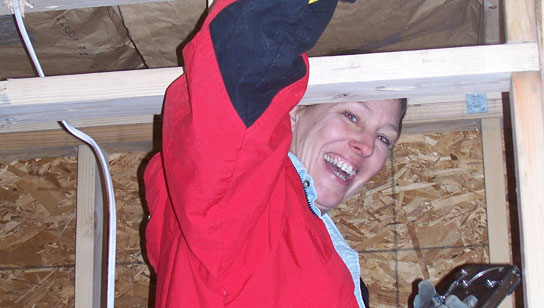RIT women team up to build homes
Nancy Raco, staff assistant in NTID’s information and computing studies department, works on a Habitat for Humanity home.
A prototype Habitat for Humanity home garnering national attention got a little help from seven RIT/NTID women faculty and staff members—three deaf and four hearing—who volunteered recently to help build the home in Rochester’s Susan B. Anthony Square historic neighborhood as part of the Flower City Habitat for Humanity Women Build project.
This is the fifth Women-Build home in the Rochester area. Karen Beiter, Donna Lange, Elissa Olsen, Myra Pelz, Debbie Poe, Nancy Raco, and Sarah Remelt, all from NTID’s information and computing studies department, spent a day working on the two-story Greek revival home located on Madison Street. “Working on a Habitat house is something I have wanted to do for a long time, but felt that I couldn’t participate because of communication issues,” says Poe, a deaf faculty member. “The hearing women of our department worked so well together with us and the supervisor at the site. Communication was not a problem at all.”
The project is the first collaboration between Flower City Habitat for Humanity and the Institute of Classical Architecture and Classical America. The group picked three national sites—Rochester, Savannah, Ga. and Norfolk, Va.—to build homes that are both affordable and blend in with and contribute to an area’s historic neighborhood. Most Habitat homes are one-floor vinyl sided structures; the Madison Street home, located in a historic preservation district, required builders to make extra efforts to complement the neighborhood’s character.
The estimated $15,000 needed to cover the additional cost was generated through fundraising. The volunteers were asked to wield whatever tools they had previous experience with, and some new ones as well, during the day. Most of the NTID group nailed braces and brackets, measured and cut wood for supports, and installed supports for a wrap-around porch on the property. “Working together was a lot of fun,” says Sarah Remelt, staff assistant. “We combined our collective knowledge and skills so we could get as much done as possible. We really wanted to make a contribution to the house and I feel we did.” The Women Build program was established by Habitat for Humanity International to encourage women’s involvement. Women crews have already built more than 800 Habitat for Humanity houses within the U.S.





